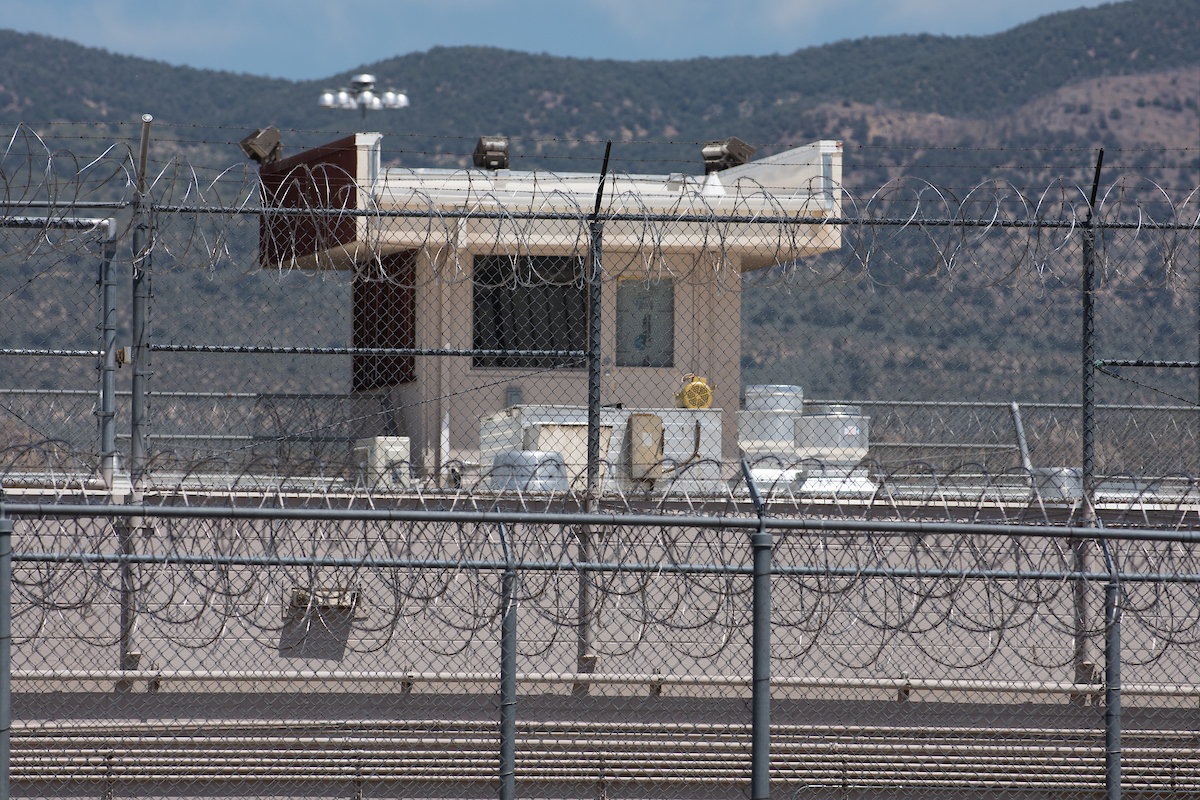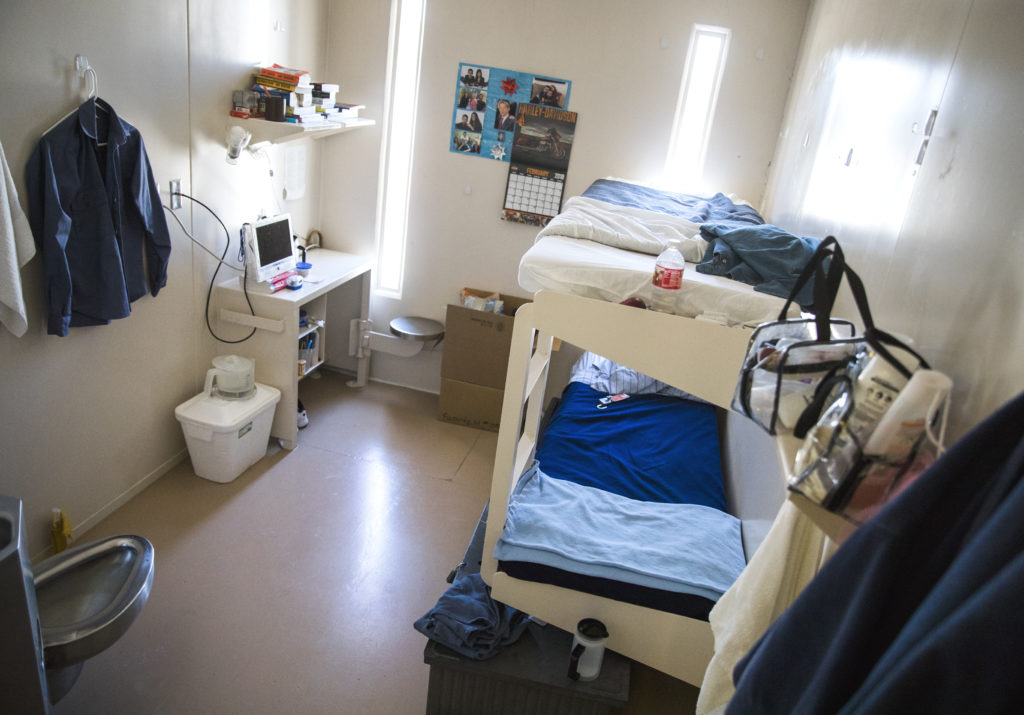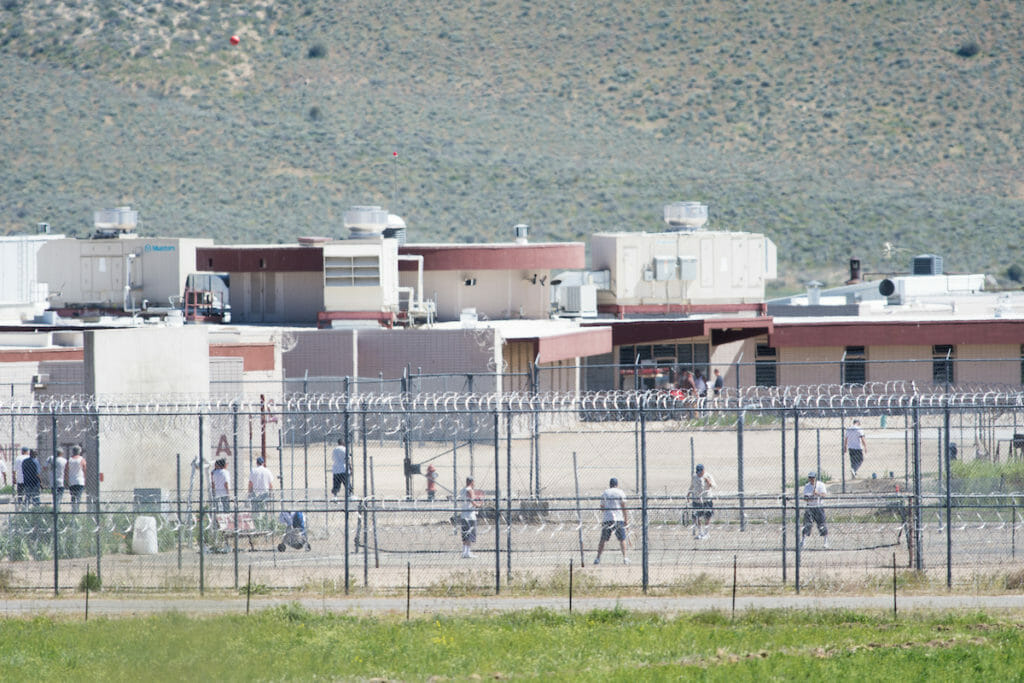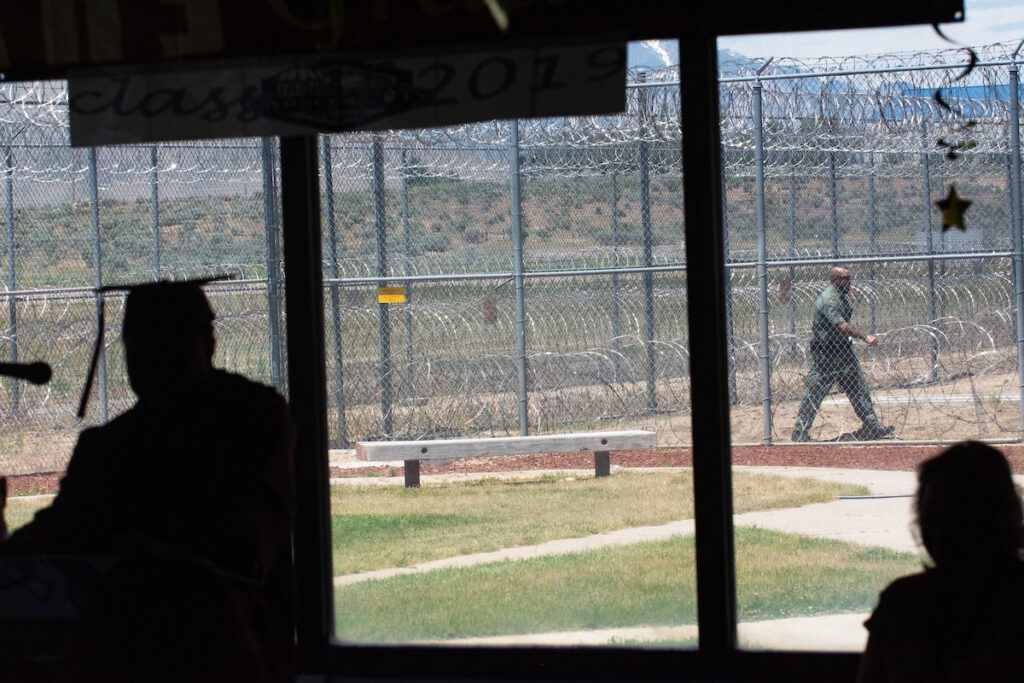Report: Nevada continues to rely heavily on isolating inmates, including some with serious mental illness

Nevada prison officials made headlines in 2017 when they told lawmakers that some inmates with serious mental illness had been in solitary confinement for years — potentially violating the Constitution — and promised the agency was moving away from the practice.
But a new report from the Vera Institute of Justice indicates the problem has not been fully resolved: The group found that more than 12 percent of Nevada prison inmates are in “segregation” — a number that researchers say is on the high end relative to other states — and some in isolation have serious mental illness. They also found that while the number of people explicitly sent to segregation as punishment went down, there was an increase in the number of people sent to segregation for murky and ill-documented “administrative” reasons.
“I think that the Vera report just solidifies and validates everything we say has been occurring with solitary confinement practices in the Nevada Department of Corrections,” said Holly Welborn, policy director at the ACLU of Nevada, which has pushed bills to limit the practice and published a report in 2017 with firsthand accounts of people who spent time in segregation. “It’s a process that’s overused.”
There’s no standard definition of “segregation” or “restrictive housing,” but it generally refers to a situation in which a person is removed from a prison’s general population and confined to a cell — either alone or with a cellmate — for 22 to 24 hours a day with few if any formal activities.
“Often the argument for solitary is for safety, right? It's to keep the prison safer, to keep society safer,” said Elena Vanko, one of the Vera Institute researchers who worked on the Nevada report. “But there really isn't the evidence to support that solitary ... changes people's behavior or deters misbehavior.”
Through a document review, site visits and focus groups with staff and inmates, Vera found that out-of-cell time varies widely in Nevada institutions. Although policies call for activities in the units, the inmates there do not have jobs, small-group recreation or other social activities — confinement that some inmates in the ACLU’s 2017 report said changed their personalities and made them feel “like we are lost to the world.”
“People’s brains are literally deteriorating. Being caged in the hole makes people angry, violent, and bitter,” wrote one inmate, “Alex.” “There is nothing positive about this, all it does is create monsters.”
But the Vera report also reaffirmed Nevada Department of Corrections (NDOC) administrators, under the direction of recently departed Director James Dzurenda, were committed to making progress on the practice. Researchers noted that NDOC had reduced the maximum length of disciplinary segregation sanctions to 60 days for most offenses, down from two years or more, and moved many seriously mentally ill inmates out of solitary and into a mental health unit.
Vera is urging even more changes, suggesting that maximum terms of segregation be reduced to 30 days, and even then only in response to the most serious and violent offenses. The new leader of the agency, NDOC Acting Director Harold Wickham, said in a statement that the report should be helpful for implementing changes.
“Vera Institute has demonstrated in other states like Washington and Louisiana that it’s possible to improve prison safety and public safety by significantly reducing the numbers of people in isolation,” Wickham said. “The results of this study will provide Nevada’s political and prison leadership alternatives to large-scale reliance on segregation and isolation.”
Correctional officers on the ground say they want to be involved in the conversation.
“As front-line workers, we hope NDOC will include correctional officers and non-custody staff in discussions about any and all departmental policy changes,” George Davis, a senior correctional officer and president of the AFSCME Local 4041 Great Basin Chapter, said in a statement.
Here are some takeaways from the report, which was developed with funding from the U.S. Department of Justice’s Bureau of Justice Assistance.

Isolating conditions in segregation
Part of Vera’s study involved site visits to five Nevada prisons and a focus group for people who had experienced segregation.
“We heard from a lot of people that it was just very isolating, not a lot to do ... very hard on the psyche,” Vanko said. “There's a lot of research showing that mental illness can develop when someone spends a lot of time in segregation — just no interactions. The few interactions that there may be is just with a corrections officer who's bringing your tray.”
The Vera Institute argued for better conditions within segregation units as a way to prepare inmates to leave the restrictive housing unit and the prison itself. Prisons should focus on minimizing isolation, boredom and sensory deprivation, as well as providing positive socialization to ensure a healthy body and mind, report authors said.
“There will always be some people who may need to be separated from the general population of a prison or jail for safety reasons,” Vanko said. “But what Vera believes is that that separated environment doesn't have to look like solitary confinement. It doesn't have to mean a person's in their cell 23 hours a day and for the one hour they're out they’re put in restraints and they only go to a small yard … it should still provide programming. If the person has mental health needs, they should get an adequate mental health treatment, things like that.”
Researchers called for ensuring conditions in segregation match the general population’s as much as possible, including having more out-of-cell recreation, ensuring regular access to phone calls and visitors, and providing “meaningful programming and treatment.”
That’s not always happening now. Phone or visitation privileges were revoked on about 1,700 occasions in the first three quarters of 2017, even though one prison policy prohibits such a sanction unless an inmate committed an offense related to visitors.
“A great deal of research demonstrates the importance of communication and maintaining family engagement for both incarcerated people and their loved ones,” the report said. “Frequent and meaningful family visits can lead to better outcomes for incarcerated people, including fewer infractions while incarcerated and a lower risk for recidivism.”
Although time out of a cell is a goal, staff interviewed as part of a focus group noted that many inmates in segregation turn down even the few opportunities to leave their cell.
“This was confirmed by many incarcerated people, who cited reasons such as recreation taking place in small individual enclosures where there is not anything to do, and sometimes being offered recreation at inconvenient times (like at night),” researchers said.
Outdoor recreation opportunities for people in segregation should be held at reasonable times of the day and in places suitable for exercise, rather than small recreational enclosures currently being used, researchers said. To address bad weather, prisons should offer recreation time in a dayroom or in a special exercise cell.
Aside from the recreational opportunities, staff should seek out more opportunities for inmates to be productive when they are in their cells, such as increasing access to reading materials and activities through TV, MP3 players or tablets, researchers said. They also suggested consulting with incarcerated people, who might have their own ideas for activities within cells.

People in segregation for longer than they should be
Although the Vera Institute found that NDOC was reducing its use of “disciplinary segregation” — when someone is isolated from other inmates as punishment for bad behavior — there was a commensurate increase in “administrative segregation,” a category of isolation used for a variety of reasons including that the person is under investigation or considered a danger to others.
The number of people ordered to disciplinary segregation in Nevada prisons fell from a high of 876 in the fourth quarter of 2017 to 554 in the third quarter of 2017, and the average length of the term in isolation fell from nearly six months in 2016 to just over two months in 2017.
Meanwhile, the number of people in administrative segregation jumped from 822 to 966 from early to mid-2017.In all, there are nearly 14,000 inmates in the Nevada prisons and correctional camps.
The trend raises questions about whether staff send people into administrative segregation as an informal punishment.
“It is important to determine whether the increase in [administrative segregation] use may be an unintended consequence of the disciplinary reforms and subsequent decreased use of [disciplinary segregation] —whether, for example, some staff may unofficially be using AS in place of DS,” the report said.
Unlike the disciplinary version, administrative segregation offers no clear pathway out and there’s no limit on how long someone can be there. Staff at some prisons told Vera researchers that they knew of people who had been in administrative segregation for years.
The report also identified another shortcoming: that many people are placed in segregation that is intended to precede a disciplinary hearing, but that hearing never happens or it takes a long time — 45 days or more — to wrap up.
On the back end, a shortage of beds in the general population can mean people who no longer need to be in segregation wait in segregation units for weeks or months before transferring out.
“This increases NDOC’s segregation population and means numerous people are in restrictive housing conditions even though the department has determined that there is no reason for them to be there,” the report said.
Vera found that In the third quarter of 2017, the average woman who was leaving segregation had been there for 73 days, while the average man had been in segregation for between 18 to 46 days, depending on the institution.
Researchers recommended more frequent review of segregation placements and checkups on whether people should remain there or should be allowed to return to the general population.
People abruptly moved from segregation into the community
Vera researchers faulted the state for a process that abruptly returns inmates from segregation into the outside world. In the third quarter of 2017, more than 15 percent of people released from prison were either released directly from segregation or within 30 days of being there.
“This practice means that people are moved quickly from an extremely restrictive and isolating environment to a community environment that requires autonomy and complex social interactions, which adds difficulty to the already challenging process of reentering the community,” the report said.
They said it’s “critical” to put safeguards in place that prevent such abrupt releases.
People with mental health issues remain in segregation
Although NDOC’s policy says people with serious mental illness should not be assigned to disciplinary segregation, incomplete records and a lack of detail about why people are in administrative segregation makes it difficult to tell whether staff are adhering to the policy.
The report found that a full 41 percent of people in segregation had some sort of mental health flag in their files, and a portion of those were classified as severely mentally ill.
Meanwhile, correctional officers — including those who work in mental health units — do not receive training in mental health beyond the standard pre-service training all officers receive, the report said.
Vera recommends mental health care training be offered to all officers.The need is particularly acute at the state’s sole women-only prison, Florence McClure Women’s Correctional Center, where nearly half of the inmates are said to have a mental health issue, and about 15 percent have a serious one.
“Staff and incarcerated people across multiple facilities also described a great need for mental health staff, mental health training for custody staff, and more available and meaningful mental health treatment and programming,” researchers said.

A better way?
Vera recommends segregation should only be used as a last resort to protect the safety of staff and other inmates, and that people in isolation should be held in the least restrictive environment for the shortest time possible.
Lower-level offenses, such as the very common offense of having contraband, refusing to participate in programming or trading and bartering, should never lead to segregation if they are non-violent, researchers said. Offenses like self-mutilation should not lead to discipline, but should lead to medical and mental health care.
Correctional officers should be trained to seek out alternative punishments, including verbal warnings and revocation of certain privileges, researchers said. Vera recommends training on crisis intervention, “motivational interviewing” and other practices that can de-escalate tense situations.
It can be a culture change for staff and take patience to try new techniques instead of relying on segregation to maintain order, Vanko said. But the changes can improve their working conditions.
“A lot of times once staff start to see that one, the sky's not falling, and two, maybe things are actually getting better — a lot of times then they do buy in and then talk to their coworkers and tell them about the great thing that's happening on their unit,” she said. “People aren't shouting and banging on the doors all the time. It's making their day less stressful, making their job less stressful.”
Welborn said she believes inexperience and inadequate training drives an overreliance on segregation in Nevada prisons as a tool to maintain order.
“They want to get people in and hired because they have a recruitment and retention problem,” she said. “They train people then they leave for higher paying county jobs. They rush those trainings.”
She also said understaffing contributes to the problem — but the solution is not just more staff, but reforms that could reduce the prison population overall.
The governor’s office said the state had made “tremendous strides” in reforming the state’s prison system since the end of the legislative session. Among other things, it pointed out that the state had applied for a Department of Justice criminal justice reform implementation grant to fund diversion programs, specialty courts and mental health treatment programs to redirect people destined for prison.
“The Office has been engaged in implementing [criminal justice reform bill] AB 236 by reconstituting the Nevada Sentencing Commission and creating the executive branch Department of Indigent Defense Services and the new Indigent Defense Board,” Gov. Steve Sisolak’s office said in a statement. “The Governor looks forward to continue building on this progress over the course of his first term.”
Meanwhile, the ACLU is continuing to push for both new changes and enforcement of existing law limiting solitary confinement — she said her organization has struggled to get public records that would show whether a 2017 law is being enforced. Their ultimate goal is the “Mandela rule,” in which solitary confinement is used no more than 15 days at a time.
They’ll be looking to someone who can carry on the mantle of Dzurenda, whose reformer record in New York and Connecticut gave them hope, Welborn said. Dzurenda departed last month and is set to work as a consultant helping North Las Vegas reopen its mothballed jail.
“We were disappointed with many decisions made under his leadership, such as the way the DOC handled execution protocol transparency and its failure to provide full access to medications for transgender inmates,” Welborn wrote. “But he valued human dignity and meaningfully advanced policies the ACLU of Nevada has been fighting to achieve, including solitary confinement reform. The Board of Prison Commissioners needs to appoint a Director who also respects human rights.”
Officials from the governor’s office said they are actively searching for a replacement.
“The ideal candidate will further the Governor’s vision of treatment, diversion, and personalized justice, suited to ensure that Nevada is safe and that those who commit crimes are treated effectively and rehabilitated appropriately, where possible,” said Sisolak spokesman Ryan McInerney.
